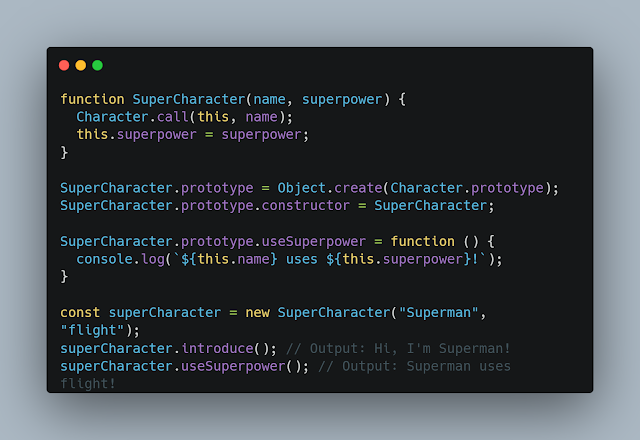We've all heard that in the world of programming, JavaScript is like the wild west. It's flexible, dynamic, and sometimes downright unpredictable. So when you come across phrases like "prototypes" in JavaScript, you might be left scratching your head. But fear not, because today we're going to unravel the mystery of prototypes in JavaScript with a clear and simple example. 🚀
What's the Deal with Prototypes?
Before diving into examples, let's break down the basics. You see, in JavaScript, everything is an object. And objects in JavaScript have a special hidden property called a prototype. This prototype is essentially a reference to another object that is used as a fallback source for properties or methods when the object itself doesn't have them. Think of it as a library of functions and properties that objects can borrow from when needed. 📚
The Prototype Chain
To understand prototypes, you need to grasp the concept of the prototype chain. It's like a family tree where objects inherit features from their ancestors. In JavaScript, objects can be linked together through their prototypes, creating a chain. When you try to access a property or method on an object, JavaScript will look for it on the object first. If it can't find it there, it will follow the prototype chain until it either finds what it's looking for or hits the end of the chain, where it defaults to null. It's like a relay race where objects pass the baton of functionality. 🏃♂️
Let's Dive into an Example
Now, the best way to learn is by doing, right? So let's take a look at a real-world example to illustrate this concept.
Imagine we're building a simple game with characters. Each character has a name and a method to introduce themselves. Here's how we can create two characters using prototypes:
javascriptfunction Character(name) { this.name = name; } Character.prototype.introduce = function () { console.log(`Hi, I'm ${this.name}!`); } const character1 = new Character("Alice"); const character2 = new Character("Bob"); character1.introduce(); // Output: Hi, I'm Alice! character2.introduce(); // Output: Hi, I'm Bob!
In this example, we define a Character constructor function, which takes a name as a parameter. We then add a method introduce to the Character prototype, which allows each character to introduce themselves.
When we create character1 and character2 and call the introduce method on them, JavaScript looks for introduce on the objects. Since it doesn't find it there, it follows the prototype chain and finds the introduce method on the Character prototype. As a result, each character introduces themselves using the method from the prototype.
Modifying Prototypes
Now, what if we want to modify the behavior of our characters? Let's say we want to add an age property to our characters. We can do this by modifying the prototype:
javascriptCharacter.prototype.age = 25; console.log(character1.age); // Output: 25 console.log(character2.age); // Output: 25
By adding age to the Character prototype, both character1 and character2 can access it. However, if we ever decide to change the age, all characters created from this prototype will reflect that change.
Creating a Prototype Chain
One of the most powerful aspects of prototypes is the ability to create chains of inheritance. Imagine we want to create a more specialized character, a SuperCharacter, which has all the properties and methods of a regular character but with some additional superpowers. We can do this by creating a new constructor function and linking its prototype to the Character prototype:
javascriptfunction SuperCharacter(name, superpower) { Character.call(this, name); this.superpower = superpower; } SuperCharacter.prototype = Object.create(Character.prototype); SuperCharacter.prototype.constructor = SuperCharacter; SuperCharacter.prototype.useSuperpower = function () { console.log(`${this.name} uses ${this.superpower}!`); } const superCharacter = new SuperCharacter("Superman", "flight"); superCharacter.introduce(); // Output: Hi, I'm Superman! superCharacter.useSuperpower(); // Output: Superman uses flight!
In this example, we create the SuperCharacter constructor function, which takes a name and a superpower. We use Character.call(this, name) to ensure that the name property is set correctly for our super character. Then, we set up the prototype chain by using Object.create(Character.prototype) to link SuperCharacter to the Character prototype.
As a result, our superCharacter inherits the introduce method from the Character prototype and has its own useSuperpower method.
The Power of Prototypes in JavaScript
Prototypes are at the heart of JavaScript's inheritance model, and understanding them is key to becoming a proficient JavaScript developer. They allow you to create efficient and organized code by reusing properties and methods across objects.
To sum it up, prototypes in JavaScript:
- Enable objects to inherit properties and methods from other objects.
- Form a prototype chain where objects can borrow functionality.
- Are a powerful tool for creating efficient and maintainable code.
So the next time you hear about prototypes in JavaScript, don't be intimidated. Embrace them as a fundamental feature that makes JavaScript so flexible and versatile.
Conclusion
In the world of JavaScript, prototypes are like the silent wizards working behind the scenes, allowing objects to inherit and share their magical powers. We've taken a deep dive into the concept of prototypes, explored the prototype chain, and even built our own characters with superpowers to illustrate the power of prototypes in JavaScript.
Now, armed with this knowledge, you're better equipped to write cleaner, more organized, and efficient JavaScript code. So go forth, code like a pro, and remember that when it comes to JavaScript, prototypes are your trusty sidekicks in the quest for coding excellence. Happy coding! 🚀🔮
